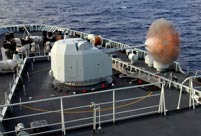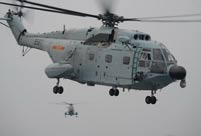Whilst many media discuss aircraft carriers, they often ignore their power systems. When compared to the shape of a huge aircraft carrier, or the power of its aircraft, or its large-scale fleet escort, the deeply buried internal power system might appear mundane. But an aircraft carrier is not just a floating platform - like modern fighters it also requires considerable power to reach high speed and meet the needs of the equipment on the ship.
In addition, the aircraft carrier's catapult system is a factor to be taken into consideration. This is an issue that has attracted the attention of many of the experts who are discussing China's future aircraft carrier. Whether it is a steam or an electromagnetic catapult, it not only represents a high-technology process, it is also directly relevant to the power of the aircraft carrier. Thus the vessel’s power is a highly critical indicator and a core technical element in evaluating the performance of an aircraft carrier.
Considerable power is required to meet an aircraft carrier’s tactical requirement to maintain a high speed.
First, the take-off and landing requirements of its aircraft mean that an aircraft carrier must maintain a certain speed. In essence they are taking off and landing on a sea-borne airport. The basic laws of physics mean that an aircraft must achieve the required takeoff speed to become airborne.
For an aircraft carrier with Ski Jump takeoff equipment, the speed is even more important. Since there is no catapult, the takeoff weight of the aircraft must be limited. As a carrier’s speed is reduced, so it will limit the takeoff weight of its aircraft, directly affecting their combat radius and their weapon-carrying capacity. This results in a significant reduction to the carrier's comprehensive combat capability.
Second, the navigational speed is important to the vessel’s mobility. The aircraft carrier is intended for combat far out at sea rather than close to home shores. Its speed directly affects an aircraft carrier’s deployment time. The farther the range of naval combat, the greater the impact of maneuvering speed. In the Falklands War, the British Task Force took nearly 30 days to reach the Falklands, the aircraft carrier’s cruising speed being only 18 knots. A nuclear-powered aircraft carrier’s cruising speed of more than 30 knots would improve the journey time by at least 8-9 days. Time is very important in modern warfare.
Third, maneuvering speed is particularly relevant to the safety of an aircraft carrier in anti-submarine warfare. In waters which might hide enemy submarines, a carrier will frequently make extreme tactical maneuvers whose purpose is to make it difficult for submarines lying in wait to judge its movement and direction. This makes it harder for them to find an opportunity to attack. Extreme mobile tactics require that the carrier’s battle group should be capable of maintaining a speed of 16-22 knots under normal circumstances. In the case of low wind, this can be increased to 29 knots. An aircraft carrier battle group maintains a high speed to reduce the opportunities for an enemy torpedo attack on its position, to make it harder to trace its passage, and to make it difficult to take advantage of any information scouted. Moreover, it also means that a submarine will need several hours to enter the wake of aircraft carrier battle group from the flanks. All of this serves to reduce the effectiveness of enemy submarine attacks.
For all these reasons countries will run their aircraft carriers at maximum speed during testing, in order to determine whether they fulfill the design specifications.
 Highlights of opening ceremony of Sochi 2014 Winter Olympic Games
Highlights of opening ceremony of Sochi 2014 Winter Olympic Games Highlights of Chinese New Year celebrations around the world
Highlights of Chinese New Year celebrations around the world  Chinese ship formation conducts live fire training in West Pacific
Chinese ship formation conducts live fire training in West Pacific Sanya bans skinny dipping in public beach
Sanya bans skinny dipping in public beach Top 20 most beautiful Chinese stars
Top 20 most beautiful Chinese stars  PLA navy conducts landing drills in South China Sea
PLA navy conducts landing drills in South China Sea  Snowscape in Chinese New Year
Snowscape in Chinese New Year Top 10 timeless female Chinese stars
Top 10 timeless female Chinese stars Top 10 Chinese films in 2013
Top 10 Chinese films in 2013 New Year greetings from Chinese nationals in Africa
New Year greetings from Chinese nationals in Africa Miss Chinese Int'l Pageant 2014 held in Hong Kong
Miss Chinese Int'l Pageant 2014 held in Hong Kong Severe coldness freezes large parts of China
Severe coldness freezes large parts of China  Beautiful moments of Sochi
Beautiful moments of Sochi  It's not just performing this year
It's not just performing this year Selfies of "Little colorful flag" girl unveiled
Selfies of "Little colorful flag" girl unveiled Day|Week|Month